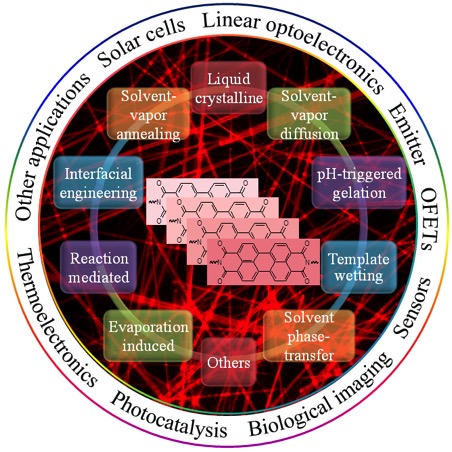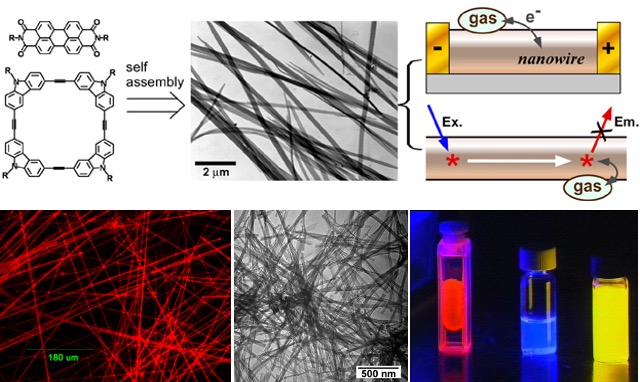
 |
Department
of
|
|
Home |
The Zang Research Group
|
||||||||
|
||||||||
Prof. Ling Zang USTAR Office: SMBB 5543, Tel. 801-587-1551 Department Office: CME 209, Tel. 801-585-0966 Fax: 801-581-4816 Email: lzang@eng.utah.edu Mailing Address: 122 S. Central Campus Drive, #304, Salt Lake City, UT 84112-0056 Lab location: 5th floor SMBB 36 South Wasatch Dr., Salt Lake City, UT 84112 A review paper published in Chem. Rev. 2015 "Self-Assembly of Perylene Imide Molecules into 1D Nanostructures: Methods, Morphologies and Applications"  A review paper published in Acct. Chem. Res. 2015 "Interfacial Donor−Acceptor Engineering of Nanofiber Materials To Achieve Photoconductivity and Applications"  A book edited by Prof. Zang, "Energy Efficiency and Renewable Energy Through Nanotechnology" is now available at Amazon:  |
Welcome to the
Zang Research Group!
We are part of the Utah Science Technology and Research initiative (USTAR), a long-term, state-funded program to strengthen Utah's "knowledge economy." Our research covers broad range in nanoscale imaging, molecular probing, organic semiconductors and nanostructures, metal organic frameworks, porous graphitic carbons, chemosensors and devices, and the applications in chemical sensors and nanodevices. These research endeavors aim to address critical problems in the fields of public safety, health, renewable energy and environment. The implementation of this research embodies a synergy among 'making', 'measuring', and 'manipulating', aimed at breaking down conventional barriers between chemistry, physics, and engineering. Engaged students will receive training across diverse disciplines, including chemical synthesis, physical characterization, materials science, and nanoscale engineering and processing. Additionally, they will have the opportunity to collaborate within cohesive teams across various campuses, honing teamwork skills and gaining familiarity with the intellectual and scientific methods essential for solving complex scientific problems. Current Research Interests: Molecular self-assembly, nanostructure and nanomaterial, organic nanofibers and nanodevices, surface nanopatterning, nanoscale imaging, nanojunction charge transfer, fluorescence sensor, chemiresistive sensor, optoelectronic sensor, trace level detection of explosives, toxic chemicals and water pollutants, metal organic frameworks (MOF), porous graphitic carbons (PGC), removal and degradation of PFAS. Selected Review Articles: 1.
Ling Zang*, Yanke
Che, Jeffrey S. Moore*, One-Dimensional
Self-Assembly of Planar pi-Conjugated
Molecules: Adaptable Building-Blocks for Organic
Nanodevices, Accounts of
Chemical Research, a special issue on
nanoscience, 41 (2008),
1596-1608. 2.
Ling Zang*,
Interfacial Donor−Acceptor Engineering of
Nanofiber Materials To Achieve
Photoconductivity and Applications, Accounts
of Chemical Research, 48
(2015) 2705-2714. 3.
Shuai Chen, Paul
Slattum, Chuanyi Wang*, Ling Zang*, Self-Assembly
of Perylene Imide Molecules
into 1D Nanostructures: Methods, Morphologies and
Applications, Chem. Rev.,
115 (2015) 11967-11998. 4.
Shuai Chen*,
Lishan Liang, Yuqian Zhang, Kaiwen Lin*, Mingna
Yang, Ling Zhu, Xiaomei Yang,
Ling Zang*, Baoyang Lu*, PEDOT:PSS-based
Electronic Materials: Preparation,
Performance Tuning, Processing, Applications, and
Future Prospect (Invited
Review), Progress in
Polymer
Science, 166 (2025) 101900. 5.
Zengxing Zhang,
Helin Huang, Xiaomei Yang, Ling Zang*, Tailoring
Electronic Properties of
Graphene by pi-pi Stacking with Aromatic Molecules
(Perspective), J. Phys.
Chem.
Lett., 2 (2011)
2897-2905. 6.
Jing Liu,
Benjamin R. Bunes, Ling Zang*, Chuanyi Wang*,
Supported single-atom catalysts:
synthesis, characterization, properties, and
applications (Review), Environmental
Chemistry Letters, 16
(2018) 477-505. 7.
Shuai Chen*, Nan
Gao, Benjamin R. Bunes, Ling Zang*, Tunable
nanofibril heterojunctions for
controlling interfacial charge transfer in
chemiresistive gas sensors (invited
Review), J. Mater. Chem. C, 7
(2019) 13709-13735. 8.
Yu Xue, Shuai
Chen*, Jiarui Yu, Benjamin R. Bunes, Zexu Xue,
Jingkun Xu, Baoyang Lu*, and
Ling Zang*, Nanostructured Conducting Polymers and
Their Composites: Synthesis
Methodologies, Morphologies and Applications
(Review), J. Mater. Chem.
C, 8 (2020) 10136-10159. 9.
Nan Gao, Jiarui
Yu, Shuai Chen,* Xing Xin, Ling Zang*, Interfacial
polymerization for
controllable fabrication of nanostructured
conducting polymers and their
composites (Review), Synthetic Metals, 273
(2021) 116693. 10.
Qingyun Tian,
Shuai Chen*, Jiarui Yu, Miao Zhang, Nan Gao,
Xiaomei Yang, Chuanyi Wang*,
Xuemin Duan, Ling Zang*, Tunable Construction of
Electrochemical Sensors for
Chlorophenols Detection (Review). J. Mater.
Chem. C, 10 (2022)
10171-10195.  Research Example: Organic Nanofibers for Detecting Danger at Nanoscale: molecular design, self-assembly, 1D confinement and enhancement of optoelectronic properties, and application for optical/electrical sensing of explosives and other chemical threats. see Chem. Rev., 115 (2015) 11967-11998; Accounts of Chemical Research, 48 (2015) 2705-2714; Accounts of Chemical Research, 41 (2008) 1596-1608; J. Am. Chem. Soc. 132 (2010) 5743-5750; Nano Lett., 8 (2008) 2219-2223.  Research Example: MOF based dual functional material for removal of PFAS with real time monitoring, https://pubs.acs.org/doi/10.1021/acsami.4c03389 Tech transfer: In collaboration with Gentex, we strive to transfer the functional materials and sensor technologies into real products to serve the public. Our labs and offices are located in the USTAR building, James L. Sorenson Molecular Biotechnology Building, located on the main campus of University of Utah. |
|||||||
 |
||||||||
|
web design by Scitechland |